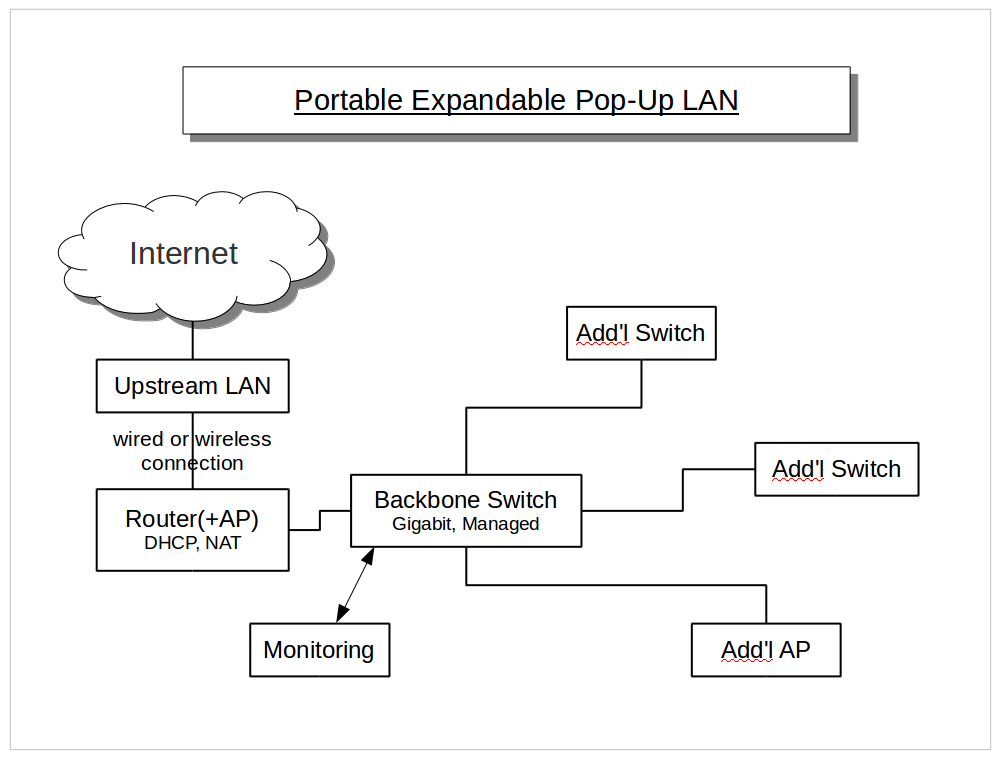If you need a secure, reliable, and expandable network at any location you can bring one with you in the form of pre-configured Portable Expandable Network Kit .
If you're planning a meeting at a remote location you can bring a pre-configured network with you rather than relying on the location's network infrastructure.
A portable network is useful--and often necessary--to assure your meeting's network will be fast, secure, reliable and predictable.
All you need to do is create one or more pre-configured Kits. This page explains how to do that.
Basic Poratble Network Kit
Here are some attributes a Kit should have:
- Small and portable
- Easy to set up and take down
- Expandable to a reasonable capacity
- Easy to replicate for redundancy
- Very predictable
- Inexpensive
A Basic Kit would fit in a padded laptop bag or small road case:
- Pre-configured router and access point
- Gigabit switch and Ethernet cables
- Long-corded surge suppressor
- Gaffer's tape
- Portable storage device
Router
Choose a router that's up to the task of providing internet connectivity to the number of hosts (connected devices) that will be on the network.
Avoid consumer routers stock firmware. A good consumer router with known-stable third-party firmware would work well. If the router has wireless, internal antennas are preferable to external. If your router has external antennas remove them for transportation.
VPN requires more power.
A device running pfSense would be a good choice for a router. Powerful and compact hardware is available. For a more modest solution a converted Thin Client Router would work well.
Access Points
For best results, use these guidelines for connecting to the portable network:
- Wired Ethernet is preferable to wireless.
- 5GHz wireless is preferable to 2.4GHz.
Wi-Fi on 2.4GHz may not be reliable in some locations because of interference.
5GHz has far less interference/congestion and it also more channels. The main disadvantages of 5GHz (range and ability to penetrate walls) aren't concerning.
5GHz is important for an access point to have. 11AC isn't essential.
It's easy to add APs if we need to increase wireless capacity. Any router with third-party firmware can be configured as a generic access point.
Mobile devices and some of the newer super-slim laptops don't have Ethernet ports. Wi-Fi is required for those.
Some older routers use a 5GHz radio that's USB internally. Those should be avoided.
Switches
A backbone switch will connect to the gateway. Other ports in the backbone are for expansion switches that expand the LAN to wherever ports are needed (e.g. at attendee tables). This "backbone / satellite" switch topology minimizes cable lengths and accommodates any room layout.
If any servers will be on the LAN, connect them to the backbone switch.
For best results, "cascading" switches should be avoided. In other words switches that expand the network should be attached directly to the backbone with as few exceptions as possible.
If you have multiple redundant kits, only one of them will connect to the upstream LAN. Each of the other kits can provide two switches, the switch and the router, which can easily be reconfigured and used as a 5-port switch.
For a meeting, a switch and a power strip provides connectivity at a table. The number of ports at a table depends on which switch.
- 4 ports - router configured as a 5-port switch
- 7 ports - 8-port switch
- 14 ports - 16-port switch
Each kit should have a second surge protector / power strip in case it's used for network expansion.
If you want to do network monitoring, the backbone switch can be a managed switch configured with a monitoring port.
Other Stuff
Gaffer's tape is more necessary than you might think. The reasons are safety and dependability. People inevitably disturb cables that aren't secured. Gaff tape is kinda pricey and you *definitely* need to use good-quality gaff tape.
The USB storage device would hold shareable files. A good (not generic Chinese) 64GB USB 3.0 flash drive would work perfectly.
The router could serve files from a USB flash device via FTP, but I don't think that's very efficient.
Multiple Kits
If you're creating multiple kits, choose the exact same device and load the exact same version of the firmware. This allows you to share configuration files.
Expanding the Network
Your portable network can expand to virtually any size.
When you need a larger network the Basic Kit's switch becomes a backbone switch for the network. An Expansion Kit connects to the backbone switch or, in a pinch, wirelessly to the main AP.
Wired Expansion Kit:
- Gigabit switch and Ethernet cables
- Long-corded surge suppressor
Wireless Expansion Kit:
- Wi-Fi access point and Ethernet cable
- Surge suppressor
Conveniently, a Basic Kit plus a surge protector creates two Expansion Kits, one of each type because a router with third-party firmware can be configured as an access point.
A router with four LAN ports becomes a 4- or 5-port switch when it's configured as an access point. The difference is whether you can use the reconfigure a WAN port to be a LAN port.
RJ45 couplers help reduce the number of cables you need because you can combine two to get a desired length.
Location's Requirements
The location only needs to provide an upstream Internet connection and one or more electrical outlets.
A cellular hotspot obviates the need for an Internet connection.
A power inverter or generator obviates the need for power.
Presenter Accommodation
- You can connect to a remote building with a wireless bridge.
- Avoid connecting expansion switches to other expansion switches. As much as possible, connect them directly to the backbone switch.
In the past I did IT for Corporate Events and learned a lot about creating a traveling rock-solid portable network that can be installed in a conference hotel, used for a week, then packed away.
